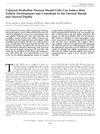Wnt Activator CHIR99021-Stimulated Human Dermal Papilla Spheroids Contribute to Hair Follicle Formation and Production of Reconstituted Follicle-Enriched Human Skin
June 2019
in “
Biochemical and Biophysical Research Communications
”
TLDR CHIR99021 helps create human skin with hair follicles, offering hope for hair loss treatments.
The study demonstrated that the Wnt signaling activator CHIR99021, in combination with a 3D spheroid culture method, enhanced the expression of dermal papilla (DP) signature genes, which are crucial for hair-inducing ability. The floating drop method was identified as the most effective 3D culture technique for maintaining these gene expressions. The CHIR99021-stimulated DP spheroids successfully contributed to the formation of reconstituted human skin enriched with hair follicles. Additionally, injected human dermal sheath cup (DSC) cells showed proper localization in the generated skin, indicating functional integration into hair follicles. This research provided a promising approach for generating human skin with functional hair follicles, potentially advancing treatments for hair loss.








